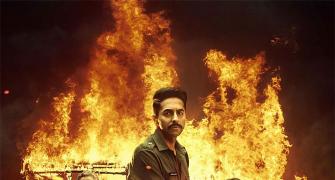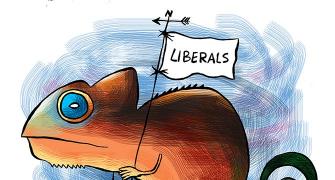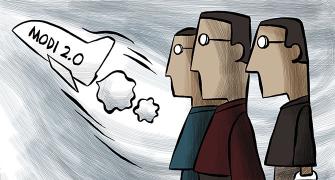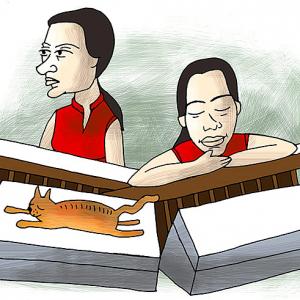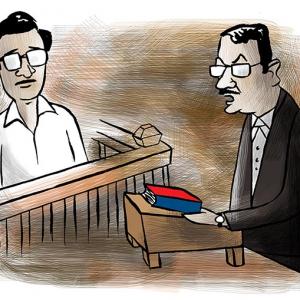Pasbola had a number of queries about the nails of the corpse found at Gagode Khurd.
Did it have nails?
Nails, in a case of strangulation, are key because they often have particles and skin beneath them to show the victim had been grasping something as s/he was strangled.
Vaihayasi Pande Daniel reports from the Sheena Bora murder trial.
Illustration: Uttam Ghosh/Rediff.com
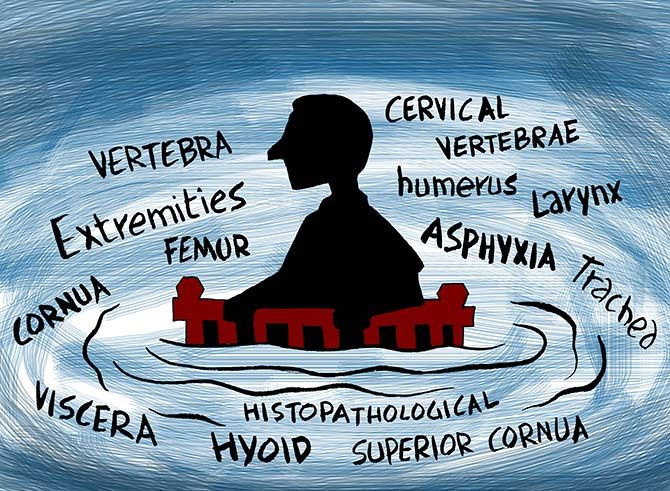
Rahul Mukerjea has not yet arrived in court this week, as was expected.
And the week is coming to a close.
News of his imminent arrival had all kinds of people, mainly journalists who don't have the time to cover the Sheena Bora murder trial regularly, popping in at CBI Special Courtroom 51, Mumbai city civil and sessions court, Kala Ghoda, with eager, looking-for-Rahul expressions fixed on their faces.
They were quite disappointed to discover first a cop, and then a doctor in the witness box, instead of Peter Mukerjea's tall son, whose face is plastered all over the Internet.
But the collection of Raigad witnesses, none of them big guns in this trial, like Rahul is expected to be, have added more drama and anticipation, and many fresh sets of question marks (exclamation marks too) -- the examination of policeman Vinod Ramchandra Bhagat and Dr Sanjay Thakur, particularly -- to the trial, than there has been in months and months.
As a court colleague put it, their testimonies have done for the case what Bangladesh's victory against the West Indies did for the 2019 World Cup.
Prosecution Witness 52 Dr Sanjay Atmaram Thakur was back on the stand on Thursday, June 27, 2019, bright and early, looking fresh and cheerful in a short-sleeved light green and white checked shirt and black jeans. There is a pink-red thread around his right wrist.
Dr Thakur, seemingly an obliging, affable sort, has a pleasant face and mobile features. His eyes are alert. He is always slightly restless in the witness box, pacing in one spot, changing his position, his hands either gripping the railing or hanging loose. Two days there have not entirely sat well with him.
He speaks very little, as if he is not comfortable talking in excess, opting to answer mostly with either a shake or a bob of his head, his expression conveying a fair bit. Although Thursday he offered a few times: "Malla mahit nahi (I don't know)."
His discomfort might be due to language issues. Dr Thakur told the court on Wednesday that he was only at ease speaking in Marathi. The lawyers wondered why, pointing out to CBI Special Judge Jayendra Chandrasen Jagdale that he was a doctor and it was sometimes difficult to phrase medical questions in any other language other than English.
The Dr D Y Patil Medical College, Kohlapur, where he studied, is an English-medium medical school. But this Pen-raised, Kamarli primary health centre medical officer, who has only practised medicine in the interiors of Raigad district, prefers to stick to Marathi.
Although he often was the first one helpfully dictating to the court stenographer the spellings of words like "extremities", "vertebra" (which got confused with vertigo), "asphyxia" and other medical terms.
Incidentally, on the flip side, negotiating a Mumbai courtroom without basic grasp of Marathi is a rather uphill task. An observer, who can't understand Marathi, would be lost. The dialogue between lawyers and the judge or witnesses and the lawyers and the judge are 50 per cent of the time or more in Marathi, especially the most fascinating bits. Only what the judge dictates to form the court record seems to be consistently in English.
The doctor had become Prosecution Witness 52 because he had conducted the post mortem of a partially-burnt corpse -- that was three years later said to be Sheena Bora's -- found ostensibly near a mango grove, on the periphery of the jungles of Raigad, close to the village of Gagode Khurd on May 23, 2012. She was allegedly killed on April 24, 2012.
Indrani Mukerjea's lawyer Sudeep Ratnamberdutt Pasbola started his cross-examination of the doctor on Wednesday with the question: "Dr Thakur, till date, has anyone asked you the final cause of death?"
Dr Thakur shook his head.
"At no point were you shown a chemical analysis report of the viscera and a histopathology report?" (The histopathological findings ie the study of tissue, aid uncovering the cause of a death, according to many medical sources online.)
Dr Thakur: "No, not shown."
Pasbola wondered if such reports were not absolutely necessary for Dr Thakur to have before him, to establish the grounds of death.
The lawyer, swiftly covered ground, soliciting answers, in a rapid sequence, about the chances of damage/change to an exposed skeleton/body from animals (specifically rodents), insects, mud, leaves, maybe due to bite or claw marks? And then on the need to measure a skeleton?
He conjectured that the organs that had fully decomposed inside the skeleton would have triggered a change in the colour of the bones and that way would have indicated the time of death?
Did the skeleton lack organs because they had decomposed or were some of the organs missing?
Was the smell emanating from the corpse due to the odour of decomposing or something else?
Were there cloth pieces or particles on the skeleton?
Dr Thakur's wordless, voiceless responses ran like this, as per my notes: Agrees with a nod. Shake of his head. Nod of his head. Nod. Shakes head. Agrees, nodding his head. Shakes his head...
Not a Dr No, since he handed out many a yes via a nod, the doctor was loathe to speak.
Translated: Animals, leaves etc can leave their mark on a skeleton; they had not in this case.
Skeletons needed to be measured, but he had not.
Bones do change colour and the organs in this corpse had decomposed while some were missing.
There was an absence of cloth/clothes on the body.
Pasbola, with his next collection of queries, determinedly circled around and around, hovering -- like a plane attempting to land at the busy Mumbai airport p-- on the topic of Dr Thakur's knowledge about the cause of death of that corpse he had examined seven years earlier in a copse of trees in Raigad.
In a thorough manner the advocate restated the same question in four or five ways.
But nope, Dr Thakur had never gotten any feedback on the basis of death for the samples he extracted from the body and gave to the police May 23, 2012.
Or even if they were sent for analysis.
And he was never asked about the way that Jane/John Doe died, he said, by the police.
Nor had he arrived at any conclusion as to how the corpse, he did a post mortem on, met its end.
And by the likes of it he had not had any curiosity then, or over the following three years about that random body/skeleton he had examined near Gagode Khurd one afternoon in May.
Either it was all in a day's work for Dr Thakur.
Or the nature of post mortems -- the doctor had done his quota of them over the 14 years he had worked at Kamarli -- around there were pretty arbitrary and uninteresting.
Whatever way you looked at it, post mortems unfolded in a strange manner in Pen and this had to be one of the oddest post mortems conducted, where no one was interested in the cause of death. Or who had died. Or if it had been a man or a woman.
Pasbola, connecting the dots between different witness testimonies, verified with Dr Thakur if photographs had been taken of the skeleton.
The doctor wobbled his head in the negative.
There were a few more questions for Dr Thakur before Pasbola shut shop for the day on Wednesday.
When the lawyer resumed at 11.30 am on Thursday, he too was consulting a chunky black medical text and Peter's lawyer Shrikant Shivade was at his side.
Pasbola was on top of his game on Thursday and like an expert cowboy he deftly attempted to lasso answers, even if they were just nods, out of Dr Thakur to suit his narrative.
The lawyer had a number of queries about the nails of the corpse found at Gagode Khurd.
Did it have nails?
Had he looked at the nails?
Or maybe they were missing?
Pasbola: "Not checked? No nails?"
Dr Thakur: "Nowti. It had nails."
The body will show internally many morphological changes if death occurred by strangling, but since this corpse had decomposed and lost its organs, those signs would not be available.
But the nails were.
Nails, in a case of strangulation, are key because they often have particles and skin beneath them to show the victim had been grasping something as s/he was strangled.
When Pasbola suggested to Dr Thakur that nails can indicate if the cause of death was asphyxia, the doctor said he did not know.
Also in Sheena's case, another lawyer elucidated, the Mukerjeas's former driver and an approver in this case Shyamvar Pinturam Rai had said in his testimony in 2017 that Sheena had scratched him.
Like Shivade, Pasbola's enquiries gradually wandered into the medical realm, leaving the non MBBSs and non-stethoscope-d behind, clueless, haplessly juggling complicated spellings and terms. One urgently needed a medical dictionary at one's side.
Some questions were about the weight of the piece of right humerus bone (long bone of the upper arm) he had extracted.
Others dwelled on the absence or presence of fractures to the humerus and the femur (thigh bone) and the condition of the cervical vertebrae (seven bones of the neck).
Pasbola: "Doctor, is it correct to say -- I am putting a proposition to you: If the hyoid and the superior cornua of the thyroid cartilage are fractured is it a case of strangulation?"
Dr Thakur: "Malla mahit nahi (I don't know)."
The hyoid bone, which fastens down the tongue, lies in front of the neck and between the cartilage of the larynx (voice box) and the lower jaw according to the Encyclopedia Britannica.
A semi-circular or U-shaped bone, it has four ends or horns called cornua. When you swallow you can feel the movement of your hyoid bone. The thyroid cartilage (that makes the larynx) also has horns or cornua.
Pasbola: "Did you notice the hyoid bone?"
Dr Thakur's head shook.
Pasbola: "Doctor Sahib, would you agree that when violent pressure is applied on the neck and the chest, amongst several injuries inflicted on the body, there is extensive bruising of the larynx and trachea with the fracture of the cornua (portion of the) hyoid bone?"
Judge Jagdale dictated the complicated question meticulously to the court stenographer, interjecting impatiently at one point to him: "Infection nahi (not). Inflicted!"
Dr Thakur, mystified, answered with the standard: "Malla mahit nahi."
Pasbola pursued it, doggedly: "But do you agree?"
The judge laughed as the lawyer tried to, unsuccessfully, coax some answer/opinion from the Sphinx Named Dr Thakur.
Even a following question about how long it takes for a body to burn till it becomes a skeleton met with the same blankness. But he agreed, with a solemn nod, that when a body burns the bones shrink and lose their shape.
Almost, like it was a game of eenie meenie miney mo or a student who had absolutely no desire to ace an exam, Dr Thakur would skip two questions and maybe answer the third, the pattern puzzlingly reflecting nothing about his body of knowledge as doctor, even if he was a GP.
Was that deliberate?
Even if you were a champ at that wonderfully engaging board game Mastermind, it was hard to detect a blueprint or interpretation to Dr Thakur's method of answering.
Pasbola, after a hurried, whispered consultation with Shivade, then popped a zinger.
He speculated if Dr Thakur had visited on October 16, 2015 the department of forensic medicine at the All India Institute of Medical Sciences, New Delhi to be examined by a panel of doctors on this mysteriously incomplete post mortem he had conducted in 2012.
Dr Thakur didn't give this question a miss. He said he had.
It turned out that one of the questions the AIIMS experts had for the Pen doctor was on the teeth (incisors apparently) the he had extracted from the lower jaw of the corpse that day under the mango trees.
Maybe they were determining if the teeth were pink, which is said sometimes, according to a lot of research, to be a sign of asphyxia.
Agreeing, Dr Thakur gestured to his own lower jaw, to indicate which teeth the no doubt august panel had asked about.
Pasbola shut his book of medicine and taking his glasses off, wound up his cross-examination, his stream of questions finally exhausted. That way journos and lawyers are quite similar -- they can never ask enough questions and go home satisfied; curiosity is the backbone of both professions.
Business closed on Thursday with the lawyer's list of accusations for Dr Thakur:
- No post mortem was carried out on May 23, 2012 by him.
- No samples had been taken from any skeleton by him.
- The doctor was deposing falsely at the instance of the Khar police.
- All the documents prepared by him had been done so later in 2015 when he was called by the police.
- The doctor had prepared these false documents on the instructions of the police out of fear of the police.
As Pasbola reeled out his allegations Dr Thakur's face wore a vacant look. At the end he tendered a slow smile and quick shake of his head.
The judge smiled.
And CBI Special Prosecutor Ejaz Khan smiled incredulously at Pasbola, holding a hand up in bafflement.
Then began the jhujhoing (intense juggling) over the next dates and times. July 4 and the time of 11 am was chosen (so Pasbola could fit other engagements in for the rest of the day) for the next bunch of consecutive hearings, with the hope of including Saturday.
Pasbola, who has weekday schedule probably as packed as the prime minister, said flatly: "Saturday kaam nahin karte hai (I don't work Saturdays)."
First Indrani, and later Sanjeev, filed out of the court to return to jail, with Indrani, who was wearing a confectionery kind of raspberry pink and sindhoor (after a long time; her divorce with Peter is not yet finalised as he recuperates) giving her former husband a sweet "See you, Sanju."
Senior Inspector Dinesh Kadam, now with the Anti Terrorism Squad apparently, made a round of Courtroom 51, to fix hearing dates with the judge, the lawyers and Khan.
Also a major, as well as complex witness in this trial, Kadam had launched the investigation into Sheena Bora's death in 2015, after it is rumoured a tip off came in from Meerut, while attached to the Khar police station.
With the Raigad round of witnesses most likely over, next week would bring to the courtroom all those connected with the case via the Khar police station, given that's the way Khan -- who is the chief traffic controller for this case, among many other things -- likes to organise witnesses.
Rahul's arrival has been indefinitely delayed for the moment, it would seem. Maybe it is linked to Peter's recovery.
Wouldn't it be easier for Rahul to depose if his father was in the courtroom?

